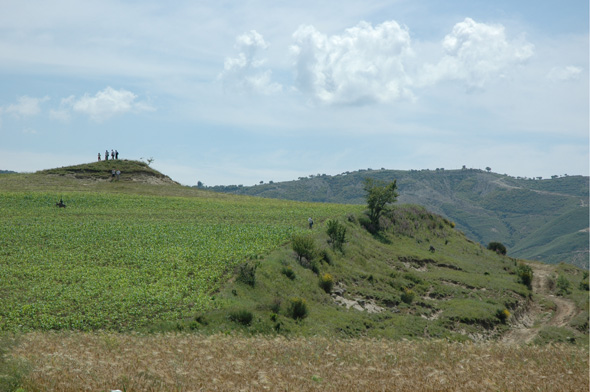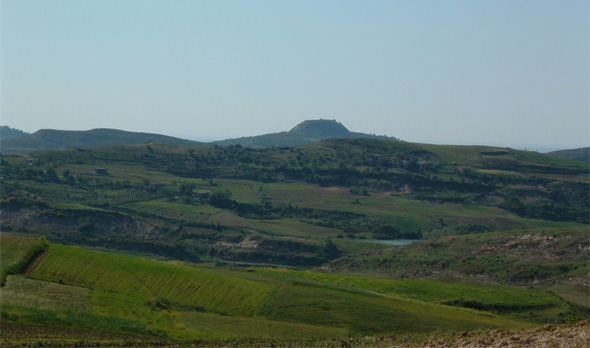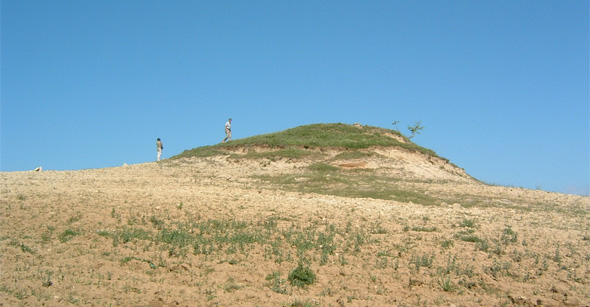 |
|
|
|
|
| |
Aims of the Lofkënd
Project The ancient tumulus of Lofkënd lies in the general area
of the Mallakastra hills, which rise to the southeast of the modern
regional
center of Fier, near the modern village of Lofkënd (sometimes
Lafkënd), which is at an altitude of some 318 meters above sea
level. The tumulus, which creates a significant shape dominating
the local landscape, and which can be viewed from fairly substantial
distances, is located in one of the richest archaeological areas
of Albania. The site is ringed by several of the most significant
fortified Proto-Urban centers – such as Margëlliç to
the west-northwest, Gurëzeze and Mashkjezë to the west,
Byllis and Klos-Nikaia to the south, Dimal to the northeast – and
more-or-less due east of the ancient Corinthian colony of Apollonia.
Important prehistoric sites in this very region include the Bronze
and Iron Age tumulus at Patos excavated by Professor Korkuti some
14 km to the northwest, the open air site and tumulus of the Bronze
Age at Drenovë, and the Neolithic settlement at Cakran (excavated
by Korkuti and Andrea), which is especially important for the Middle
Neolithic period.
|
| |
 |
A view of the Lofkënd
tumulus prior to excavation (June 2004) from west-southwest |
| |
| The overall aim of this project is to
initiate protohistoric investigations in south-central Albania, specifically
in the region focused around the tumulus of Lofkënd, in order
to investigate a number of interrelated phenomena. The chronological
range of the tumulus – which, on the basis of the collection
of surface materials appears to be Early Iron Age extending into
the Bronze Age – offers a unique opportunity to explore the
formative period immediately preceding the colonial foundations on
the coast, at Apollonia, Epidamnos-Dyrrachium and Butrint. The exploration
of a tumulus such as Lofkënd encourages not only the linking
of this prominent burial place to a particular group, or groups,
of people, it also encourages rethinking the very nature of settlement
in south-central Albania, and more particularly the role of historical
pastoralism versus agriculture. Secondly, one of the most critical
material developments in this region, namely, the establishment in
the Illyrian hinterland of a new type of site during the Proto-Urban
phase – whether true towns, hilltop refuges, or regional trading
and meeting places, such as Margëlliç, Byllis, Klos-Nikaia,
and Gurzezë – is not yet fully understood. This is equally
true for the processes of this remarkable development, as well as
the relationship of these centers with one another and with the coastal
colonies. |
| |
 |
The site of Margëlliç as seen
from the Lofkënd tumulus |
| |
The exploration of a major site in
this region predating both the foundation of the colonies and the
Proto-Urban
centers will lead to a better understanding of the historical processes
that contributed to the rise of urbanism in Illyria. The implications
for the nature of settlement in this region may be more far-reaching
and they may even contribute to a clearer understanding of the
transition from unwalled “villages” (komai), which are characteristic
of an ethnos in classical sources (according to Ps.-Scylax, Thucydides),
to fortified “cities,” and to what extent these “cities” relied
on, or differed from, the Hellenic model. It is clear that in two
Molossian (Late Bronze and Early Iron Age) cemeteries in Epirus in
northwest Greece, at Vitsa and at Liatovouni – the latter in
part a tumulus burial – unwalled “villages” to
which the cemeteries belonged have been excavated, while the Korçë-Kolonjë region
of southeastern Albania in the Late Bronze Age, and especially
the Early Iron Age, saw new settlements created on naturally defended
hilltops, fortified with walls. The questions to be asked include:
What brought about these changes? How did tumuli function in relationship
to a settlement, or group of settlements, and what was their contemporary
significance in the greater landscape? What were the patterns of
settlement and/or partial mobility in the era before cities? And
what can we learn about the city outside the historical contours
of the classical polis?
A further focus of this project is to explore mortuary customs
in south-central Albania not only from a regional and contextual
approach,
incorporating the results of excavations at other nearby and more
distant tumulus- and other cemeteries, but from a theoretical and
methodological approach that is cognizant of the latest developments
in demographic studies. Issues of age, gender, pathology, kinship
traits (the latter using DNA analysis), as well as the rituals
and philosophy of death, issues of ethnicity, and social organization
(the latter not limited to the establishment of “social status,” but
the inclusion or exclusion of certain groups on the basis of age,
gender, deviancy, etc.) are central to our research and interpretation.
In terms of excavation techniques, the project aims for total
recovery of all the archaeological material, not only artifacts,
but of all
surviving plant remains, bones and other organic material, with
a view of contributing to a better understanding of the environmental
and ecological history of the region. A particular focus of this
project will be the full and detailed analysis of all the skeletal
remains, whether inhumed or cremated, and comparison to other
excavated
populations in Albania. This will allow for more robust results
on the demography and human population in this region of Albania. |
| |
 |
The Lofkënd tumulus
prior to excavation (May 2004) from the west |
|
|
|
|